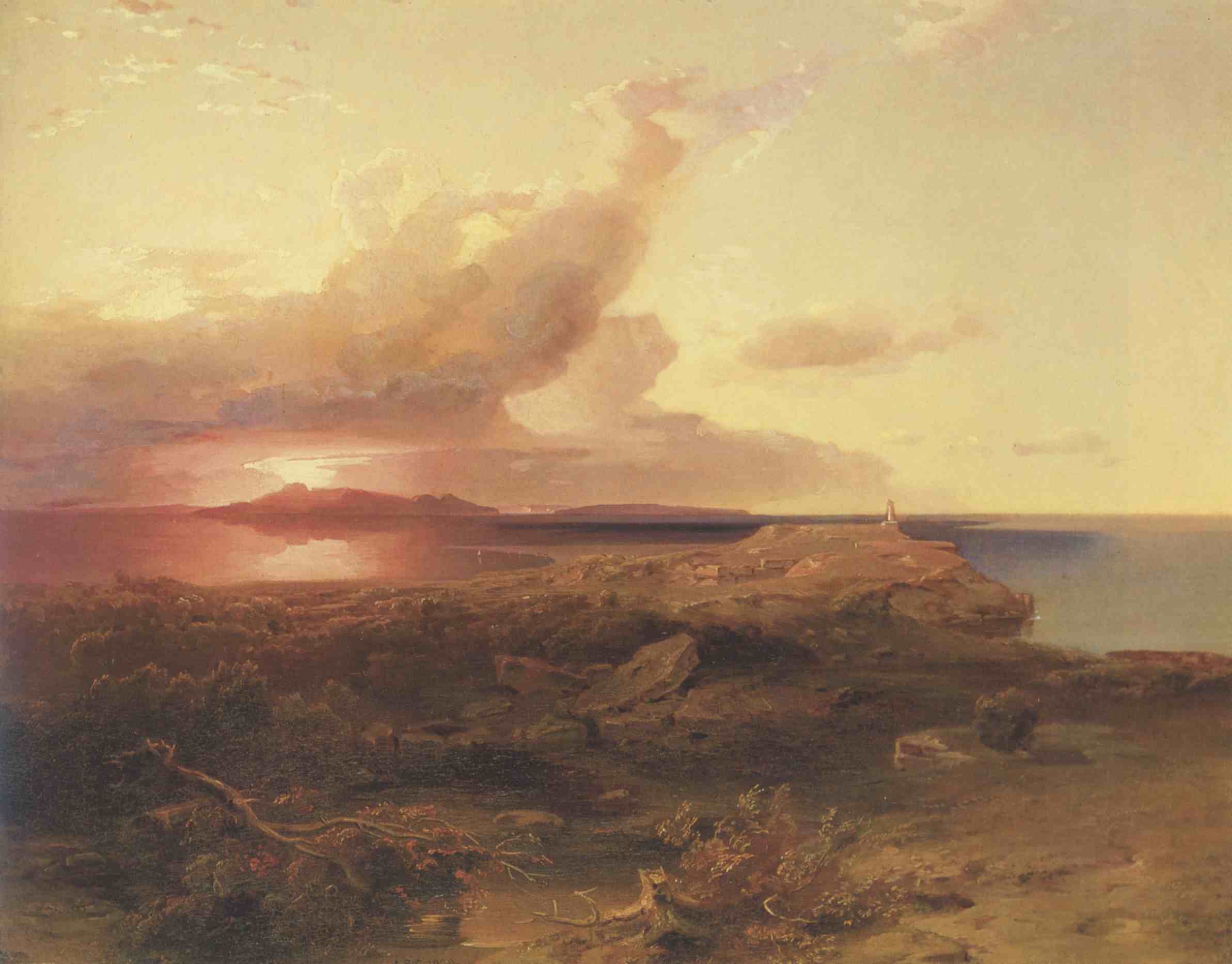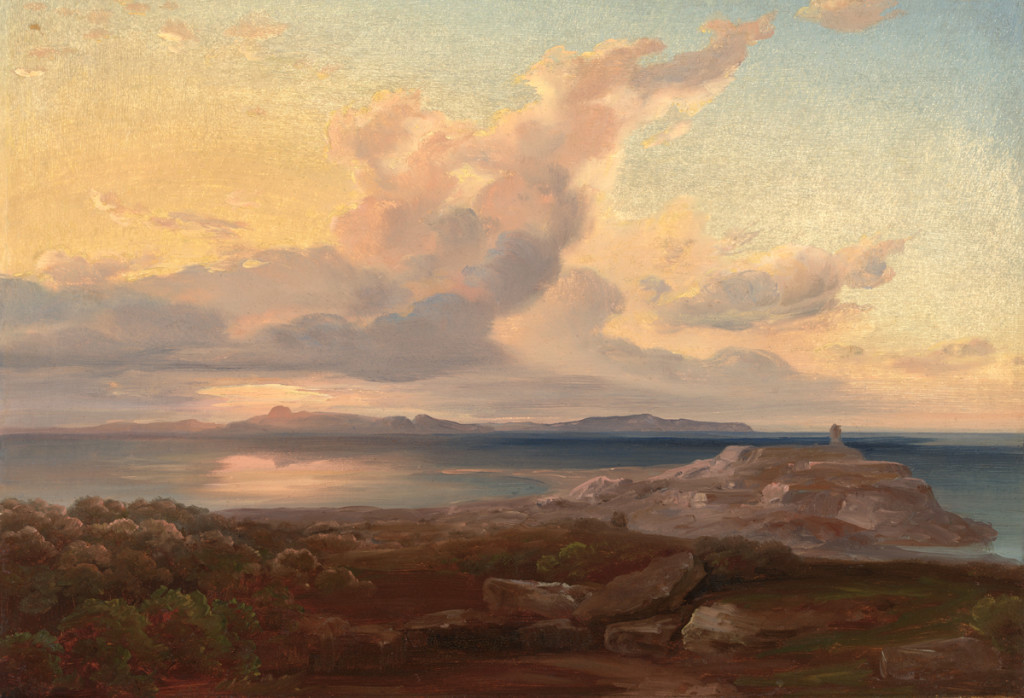Carl Anton Joseph Rottmann (Heidelberg 1797 - 1850 Munich)
A View of Aegina, with the Remains of the Temple of Apollo, 1836-40
Oil on paper on canvas, 30.5 x 43.5 cm
Exhibited:
Landschaft als Geschichte. Carl Rottmann 1797-1850. Hofmaler König Ludwigs I., Heidelberg, Kurpfälzisches Museum and Munich, Kunsthalle der Hypo-Kulturstiftung, Munich 1998, p. 285, no. 146 (repr.)
Literature:
Erika Bierhaus-Rödiger, Carl Rottmann 1797-1850. Monographie und kritischer Werkkatalog, Munich 1978, pp. 387-8, no. 616
Erika Rödiger-Diruf, ‘Landschaft als Abbild der Geschichte. Carl Rottmanns Landschaftskunst 1820-1850. Mit einem Nachtrag zum Werkkatalog von 1978’, in Münchner Jahrbuch der bildenden Kunst, XL, 1989, p. 190 and p. 207, note 141
Vampire-like, we assault famous sites and with our eyes, greedily devour their beauties, namely, the beauties of nature [...].[1] (Carl Rottmann, Athens, January 1835)
This oil study by Carl Rottmann[2] is closely connected to his celebrated cycle of Greek landscapes commissioned by Ludwig I of Bavaria. Now held in the Neue Pinakothek in Munich, the cycle offers a unique testimony to the closeness of the relationship between Bavaria and Greece in the early nineteenth century. Ludwig was an enthusiastic admirer of ancient Greece. When, in 1829, Greece emerged from the War of Independence as an autonomous state, overthrowing Ottoman rule, Ludwig was one of the first European rulers to recognize it. The great powers – England, France and Russia – concurred with the choice of Ludwig’s son, Prince Otto of Bavaria, as the first monarch of the new state. In this way a Bavarian prince and scion of the House of Wittelsbach came to be King of Greece and in the course of his reign, to lay the foundations of the modern Greek state.

Fig. 1 Carl Rottmann, Aegina – the Temple of Apollo, 1840, Karlsruhe, Staatliche Kunsthalle, 48 x 63 cm
In August 1834, Rottmann[3] set off from Munich on a strenuous fourteen-month trip to Greece – then still heavily war-scarred – to compile study material for a cycle of Greek landscapes.[4] Travelling with him was the architect and landscape artist Ludwig Lange. Their journey took them via Nafplio and Corinth to Athens. Taking lodgings in the capital, Rottmann made numerous trips to ancient sites in the vicinity and also visited the island of Aegina. On the island, he made studies of two distinctive motifs – the Temple of Aphaia[5] and the Temple of Apollo (Fig. 1)[6]. However Ludwig’s final choice of motif for the monumental cycle was the Temple of Aphaia, a decision almost certainly influenced by the fact that he owned the temple’s celebrated pedimental marbles, known as ‘the Aeginetes marbles’.[7]
This study[8] depicts the foundations of the Temple of Apollo with its one surviving, fragmentary column. The motif was clearly of some significance to Rottmann as he is known to have made a number of versions of it. The actual subject, however, is not the temple itself but the heroic landscape with its rich classical overtones. As Reinhold Baumstark notes: [It is] nothing less than an educational journey for the eye, a contemplation of historical grandeur set in a rugged, magnificent landscape firmly embraced by sea and sky. […] A romantic, melancholic monument to ancient Greece achieved by depicting modern Hellas as the deserted stage of world history, exposed to the elemental forces of nature.[9]
[1] Cited after Heilmann and Rödiger-Diruf, Landschaft als Geschichte, op. cit., p. 233.
[2] Rottmann moved to Munich from his home near Heidelberg in 1821 in search of new sources of creative imagination. He first visited Italy and Sicily in the years 1826-7. He was sent by Ludwig I on a second visit to Italy in 1829 to study and select subjects for a cycle of Italian landscapes to be painted in fresco on the walls in the western arcades in the Hofgarten in Munich. The project was completed in 1833. Ludwig appointed Rottmann court painter in 1841.
[3] For details of Rottmann’s biography, in particular regarding Greece, see Heilmann and Rödiger-Diruf, Landschaft als Geschichte, op. cit., pp. 232-7.
[4] Two years earlier Rottmann and Leo von Klenze, enthusiastically supported by Ludwig, had already outlined a design for the cycle of monumental Greek landscapes. They were to decorate the northern arcades of the Hofgarten and to provide a link with the cycle of Italian landscapes already completed. Initially designed to include thirty-eight landscape motifs, the Greek cycle was reduced to twenty-three paintings in early 1840 after it was decided to put them on exhibition in the Neue Pinakothek rather than in the Hofgarten.
[5] See Bierhaus-Rödiger, Carl Rottmann 1797-1850, op. cit., nos. 444 and 578.
[6] In addition to the present study, the following oil paintings and studies by Rottmann of the Temple of Apollo on Aegina are preserved:
- 1835-6, oil on canvas, 35 x 60 cm Stuttgart, Staatsgalerie, inv. 2162 (Bierhaus-Rödiger 445);
- c.1840, oil on canvas, probably 142.5 x 165 cm, whereabouts unknown (Bierhaus-Rödiger 617);
- c.1840, oil on board, 48 x 63 cm, Karlsruhe, Staatliche Kunsthalle, inv. 596 (Bierhaus-Rödiger 618) (Fig. 1);
- 1843-7, oil on canvas, 105.5 x 126 cm, Kassel, Staatliche Kunstsammlungen, inv. Az 559 (Bierhaus-Rödiger 640).
[7] Aegina, an island, lying a few hours’ distance from Athens in the Saronian Sea, had, in antiquity, courageously competed with Athens in matters of art and science, and the Aeginetan works of art stand as direct precursors of the artistic perfection achieved at the Parthenon in Athens. The most significant and most comprehensive Greek pieces to be found in the Glyptothek in Munich are the figures from the pediments of the Temple of Minerva on Aegina, whose vestiges reach such an exceptional peak of artistry in this painting [...]. Ludwig Lange, Die Griechischen Landschaftsgemälde von Karl Rottmann in der neuen königlichen Pinakothek zu München beschrieben von Ludwig Lange, Munich 1854, p. 20.
[8] An inscription on the verso of an oil study of the same motif in the collection of the Staatsgalerie Stuttgart is of key importance to the dating of the present study. This inscription states that Rottmann ‘observed the cloud formation and painted it later, during a thunderstorm over the Starnberger See in 1836.’ This same cloud formation recurs in all later versions of the Temple of Apollo on Aegina, although in reverse. See Bierhaus-Rödiger 445.
[9] Reinhold Baumstark in Foreword to Herbert W. Rott, Renate Poggendorf and Elisabeth Stürmer (eds.), Carl Rottmann. Die Landschaften Griechenlands, exhib. cat., Ostfildern 2007, pp. 8-9 (preface).

